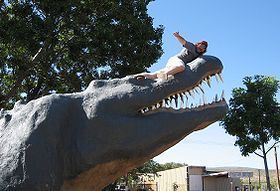Established 1886 Elevation 11 m (36 ft) Mean max temp Mean min temp Population 669 (2006 census) | Postcode(s) 6740 Postal code 6740 | |
 | ||
LGA(s) Shire of Wyndham-East Kimberley Weather 27°C, Wind E at 2 km/h, 75% Humidity | ||
Wyndham is the oldest and northernmost town in the Kimberley region of Western Australia, located on the Great Northern Highway, 2,210 kilometres (1,373 mi) northeast of Perth. It was established in 1886 as a result of a gold rush at Halls Creek, and it is now a port and service centre for the east Kimberley with a population of 800. Wyndham is split into two areas. The original town site of Wyndham Port is situated on Cambridge Gulf, while Wyndham's Three Mile area is the residential and shopping area of the town. Wyndham is part of the Shire of Wyndham-East Kimberley.
Contents
- Map of Wyndham WA 6740 Australia
- History
- Wyndham Meatworks
- Geography
- Climate
- Facilities
- In popular culture
- References
Map of Wyndham WA 6740, Australia
History
The first European to visit the area was Phillip Parker King in 1819. He was instructed to find a river 'likely to lead to an interior navigation into the great continent'. He sailed into Cambridge Gulf, which he named after the Duke of Cambridge, and then sailed up a river which was subsequently named after him. Finding no fresh water on the mudflats, he departed.
The town of Wyndham was established by John Forrest in 1886 as the major port and trading station of the East Kimberley, after finds of gold in Halls Creek a year earlier. By mid-1886, the town was booming. There were six pubs, one of which was a two-storey building. Ships brought in at least five thousand miners who headed off to the Halls Creek goldfields. It is known that during this boom there were times when up to 16 vessels were moored in Cambridge Gulf.
However, by 1888, the gold rush at Halls Creek had ended and the fortunes of Wyndham declined. Wyndham became a tiny settlement serving the pastoral interests in the East Kimberley. By 1912, money had virtually disappeared from the Wyndham economy, and purchases were paid for using promissory notes known as "shinplasters".
During World War II, the town was attacked several times by Japanese aircraft.
Wyndham's significance as a service centre was crucial for the construction of the Ord River Diversion Dam and the town of Kununurra in the early 1960s. With the rise of Kununurra as a larger population centre the significance of Wyndham as a service centre had diminished by the 1980s. Wyndham has regained significance as the port for the region with new mines shipping ore from the port.
Wyndham Meatworks
In 1913, the Western Australian government started to construct the Wyndham Meatworks to restart the town's economy. The construction efforts were interrupted by the Nevanas affair and World War I, but the meatworks were completed in 1919 to a design by William Hardwick who later became the Principal Architect of Western Australia. The meatworks were the mainstay of the town's economy until their closure in 1985; the town also supported the Air Beef Scheme which ran from 1947 to 1965.
Geography
Wyndham is on the eastern side of Cambridge Gulf, an inlet of Joseph Bonaparte Gulf in the Timor Sea. It is surrounded by the Durack, Pentecost and King rivers to the south, Forrest River to the west and Ord River to the north. Much of the land around Wyndham is inhospitable, and includes the Bastion Range and the mudflats of the Cambridge Gulf. The Bastion Range is the site of the 28-square-kilometre (11 sq mi) Wyndham Important Bird Area, identified as such by BirdLife International because it holds the largest known population of endangered Gouldian finches.
Climate
Despite being in the tropics, Wyndham experiences a steppe climate (Köppen climate classification BSh), with the wet season from late November to March and the dry season from April to early November. The hottest month is November with an average maximum temperature of 39.5 °C (103.1 °F), and the coolest month is June with an average maximum of 31.0 °C (87.8 °F). The annual average maximum temperature is 35.6 °C (96.1 °F), one of the highest in Australia. In 1946, Wyndham recorded 333 consecutive days of temperatures over 32 °C (90 °F).
Large rain events do occur in Wyndham, such as on 4 March 1919 when 12.5 inches (318 mm) of rain were recorded over a 24-hour period, followed by another 4.6 inches (117 mm) the next day.
Facilities
There are two schools, Wyndham District High School (K-12) & St Joseph's Catholic School (K-7), one TAFE campus, and a daycare centre. There is also an outdoor swimming & recreational centre for leisure. For tourists, there are two hotels and a caravan park. Wyndham is served by Wyndham Airport. The nearby Bastion lookout provides sweeping vistas of the surrounding country including the five rivers named above which emerge into the Cambridge Gulf. The town has a museum in the old courthouse that is open to the public and run by the Wyndham Historical Society.
Wyndham is also the home of the Big Crocodile, a wire and concrete statue of a crocodile around 18 metres (60 ft) long.
Nearby Wyndham is a Boab Prison Tree.
In popular culture
The Wyndham area was the filming location for the 2010 film Mad Bastards.
